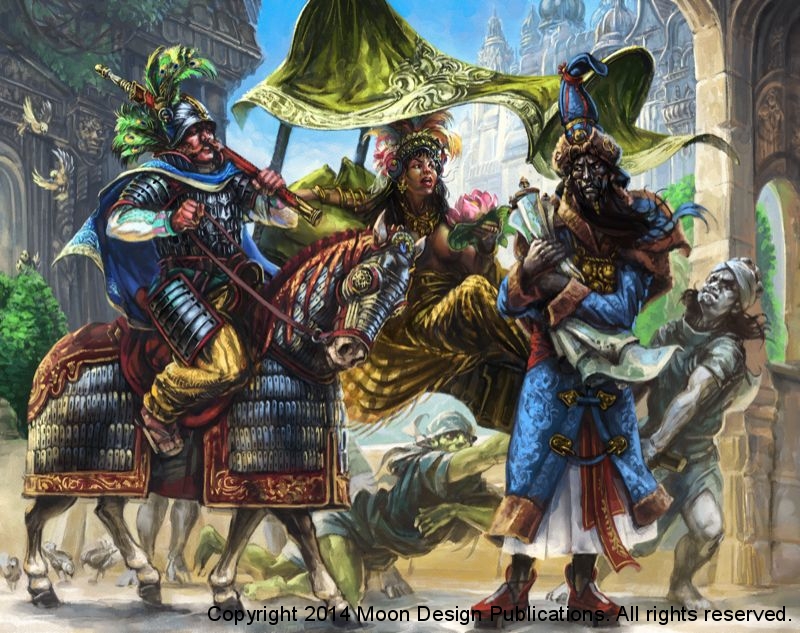So now that we got the contentious issue of what is canon out of the way, maybe I really should schedule that Malkioni Marathon – if enough people were interested, maybe we could even do a Malkioni Hangout. Along those lines – here’s Jan’s plate of the new West showing the castes of Seshnela.

This was posted on Google+
![]()
![]()
That is a zzaburi from Pithdaros, yes.
From left to right: Heavy cavalryman from one of the Seshnegi warrior societies; talar noblewoman ( I suspect she is of ancient Malkioni ancestry with her yellow-golden skin); worker of Waertagi ancestry; Pithdaran zzaburi; and worker of undefined ancestry.
This commission depicts members of the four castes (Ruler, Wizard, Soldier, Worker) of Western culture. In a nutshell, Western culture is rational, materialist, and humanist, and derived from the atheist immortal philosophies of ancient Brithos. Their society is divided into hereditary castes, each with its own rules and restrictions. Unlike the Orlanthi or Lunars, who devote themselves to the gods, the Westerners believe that it is their right to master and control the gods through wizardry.
The Scene: An open palanquin is carried by four workers through the streets of a sub-tropical large city (Noloswal to be precise). Inside the palanquin reclines a noble ruler who is being advised by a wizard (who is walking beside the palanquin). The palanquin is guarded by a member of the soldier caste (on horseback or on foot depending on how what looks better).
Palanquin: This should be open so we can see the noble woman. Something like this: http://commons.wikimedia.org/wiki/File:Litter_(PSF).png or a more open version of this: http://commons.wikimedia.org/wiki/File: … _(PSF).png.
Ruler Caste: Our noble woman reclines on a palanquin carried by four workers. This attractive woman is about 162 cm tall with light brown skin. She is bare-breasted and wears loads of golden jewelry – necklaces, earings, bracelets and anklets. Over her long black hair, wears a feathered headdress encrusted with gems (like this http://upload.wikimedia.org/wikipedia/c … 005925.jpg but with gems instead of beads). She wears a wrap-around skirt of golden silk. She is admiring a lotus blossom while listening to the wizard.
Wizard Caste: Walking besides the palanquin is a tall (178 cm) and slender Rokari wizard. He has brown-black skin (he should look vaguely Somali or Ethiopian) and the sharp features of an ascetic. His beard is black and uncut. He is attired similiar to the wizard in Western People-FINAL with long sleeved-robe, tall hat, and priestly breastplate with the Gloranthan runes on it (yes, that attire is not in the slightest bit sensible for a semi-tropical region, but the wizards maintain a tradition unchanged from the Ice Age). It is possible that the wizard is not actually nearly that tall, but is wearing platform shoes! He might be carrying scrolls or sheets of paper (with script that resembles the Gloranthan runes).
Soldier Caste: Riding or walking besides the palanquin is a sturdy man of the Soldier caste. He’s about 168 cm with pale reddish skin and brown hair. He wears scale armor (like that of a cataphract http://iranpoliticsclub.net/photos/U10- … Kushan.jpg) over a long sleeved tunic (like this http://moondesignpublications.com/files … arrior.jpg). He sports a big mustache, like this: http://www.environmentalgraffiti.com/of … 55?image=2. His arms and armor should sport an animal motif, like deer, horse, bear, boar, lion, or wolf – but pick one and stay with it (Western soldiers belong to hereditary societies with animal totems). If he rides, he rides a small horse.
Worker Caste: These men and women are about 152 cm tall with skin colors ranging from light greenish to muddy brown. They wear loincloths and a sleeveless shirt (if male) or simple straight skirts (if female). Those who carry the palanquin should be dressed similarly; if there are other types of workers (crafters, farmers, masons, etc), their clothing style and design will identify their occupation. If there are background workers (90+% of Western society belongs to the Worker caste, with dozens of sub-castes), they should all have different skin hues. The textile, colors, and design of clothing depend on the subcaste; farmers wear simple homespun linen, usually coarse and undyed grey and brown. Wealthier townsfolk (especially the trader and crafter subcastes) prefer finer textiles, and dye their clothes in those colors allowed for their subcaste (yellow, blue, and red being strictly forbidden).
Seshnengi horses are About 14 hands. Which is about right for historical cataphracts, at least from some horse burials. Admittedly, this horse was tweaked a little bit so that we could get it all in the picture.
